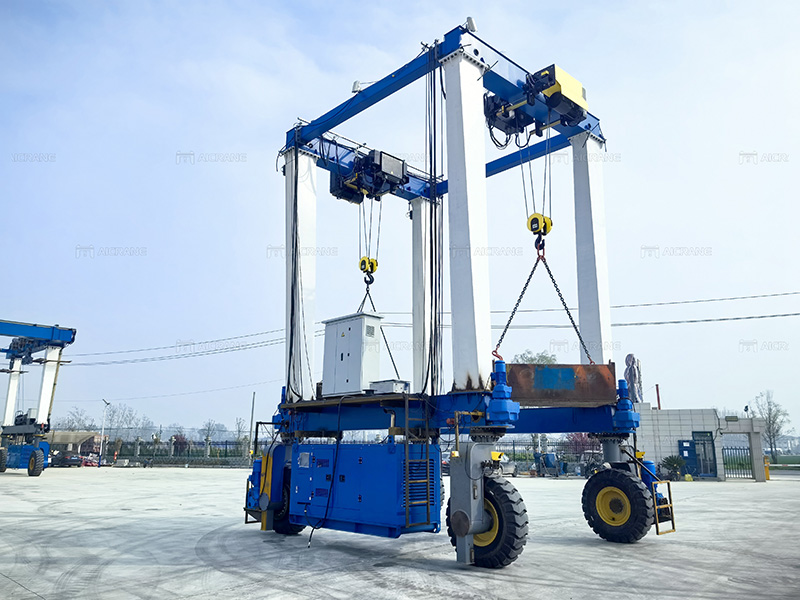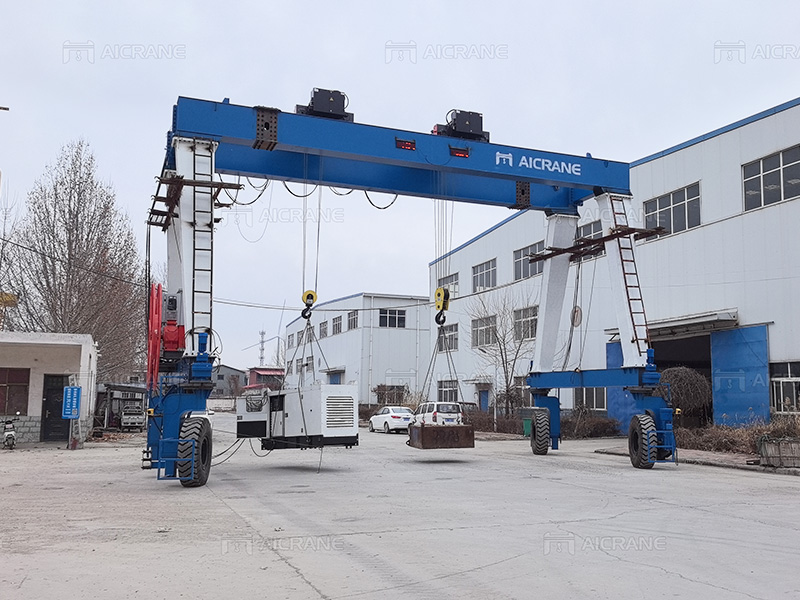Rubber-tired gantry cranes (RTGs) are pivotal in modern logistics and container handling operations, particularly in ports and intermodal terminals. They provide flexibility and mobility due to their rubber tires, allowing them to maneuver easily within tight spaces. However, like any heavy machinery, RTGs require regular maintenance, including tire changes, to ensure optimal performance and safety. This passage will detail the process of changing tires on a rubber-tired gantry crane, covering the importance of tire maintenance, the necessary tools, step-by-step procedures, safety precautions, and post-replacement considerations.

Importance of Tire Maintenance for Rubber-Tired Gantry Cranes
Tires play a crucial role in the operational efficiency of rubber-tired gantry cranes. They provide the necessary traction for movement, stability during lifting operations, and help absorb shock loads. Regular tire maintenance is essential for the following reasons:
1. Safety: Worn or damaged tires can lead to instability, increasing the risk of accidents during gantry crane operations. Ensuring tires are in good condition helps prevent rollovers or loss of load control.
2. Performance: Properly inflated and well-maintained tires contribute to better handling and maneuverability, enabling RTGs to operate more efficiently.
3. Cost-effectiveness: Regular tire maintenance, including timely replacements, can extend the life of the tires, reduce fuel consumption, and minimize repair costs associated with other damaged components caused by tire failure.
4. Compliance: Many regulatory bodies mandate regular maintenance checks, including tire inspections and replacements, to ensure safety and compliance with operational standards.
Tools Required for Changing Tires
Before embarking on the tire replacement process, ensure you have the following tools and equipment:
Jack and jack stands: For lifting the crane safely off the ground.
Wrenches and sockets: To remove the wheel nuts or bolts.
Tire changing tools: This may include a tire iron, bead breaker, or other specific tools for handling heavy tires.
New tires: Ensure you have the correct replacement tires that match the specifications of the gantry crane.
Torque wrench: For tightening wheel nuts to the manufacturer’s specifications (like Aicrane).
Safety equipment: Personal protective equipment (PPE) such as gloves, safety glasses, and steel-toed boots.

Step-by-Step Process of Changing Tires on a Rubber-Tired Gantry Crane
Step 1: Prepare the Work Area
1. Choose a flat, stable surface: Ensure the crane is parked on a flat and stable surface, away from traffic and hazards. This helps prevent accidents during the tire change.
2. Clear the area: Remove any obstacles or debris from the work area to provide a safe environment for the maintenance crew.
3. Notify personnel: Inform relevant personnel about the maintenance work to ensure that the area remains clear during the tire change.
Step 2: Secure the Crane
1. Lower the crane: Ensure the crane is in a lowered position, and the hoisting mechanism is not engaged. This prevents unexpected movements during the tire change.
2. Engage the parking brake: Set the parking brake to ensure the crane does not roll while the tires are being changed.
Step 3: Lift the Crane
1. Use the jack: Position the jack under the appropriate lifting point on the crane. Consult the manufacturer’s manual for the correct lifting points.
2. Lift the crane: Raise the crane off the ground until the tires are clear of the surface. Ensure the jack stands are securely placed to support the crane’s weight.
Step 4: Remove the Old Tires
1. Loosen the wheel nuts: Using the appropriate wrench or socket, loosen the wheel nuts on the tire you are replacing. It is often easier to loosen nuts while the tire is still on the ground due to the added resistance.
2. Remove the wheel nuts: Once loosened, remove the wheel nuts and set them aside in a safe place.
3. Take off the tire: Carefully slide the tire off the wheel hub. Depending on the design, you may need to maneuver it slightly to get it free.
Step 5: Install the New Tire
1. Inspect the new tire: Before installation, inspect the new tire for any defects or damage. Ensure it is the correct size and type for the RTG.
2. Position the new tire: Align the new tire with the wheel hub and carefully slide it onto the hub.
3. Secure the tire: Replace the wheel nuts, hand-tightening them initially. It is crucial to ensure they are seated properly before tightening.
Step 6: Tighten the Wheel Nuts
1. Use a torque wrench: Once the tire is securely in place, use a torque wrench to tighten the wheel nuts to the manufacturer’s specified torque settings. This step is vital to prevent wheel detachment during operation.
2. Check all wheel nuts: After tightening, double-check all wheel nuts to ensure they are secure.
Step 7: Lower the Crane
1. Remove the jack stands: Before lowering the crane, ensure the jack stands are clear from under the crane.
2. Lower the jack: Slowly lower the crane back to the ground until all tires are firmly on the surface.
3. Remove the jack: Once the crane is back on the ground, remove the jack and any tools used during the process.
Step 8: Post-Replacement Inspection
1. Conduct a visual inspection: After changing the tires, perform a thorough inspection of the crane to ensure everything is in order.
2. Test the crane: Before putting the crane back into service, conduct a short test run to ensure all systems are functioning correctly. Pay attention to any unusual noises or movements during operation.
3. Update maintenance records: Document the tire change in the maintenance log, noting the date, tire specifications, and any observations made during the process.
Safety Precautions
When changing tires on a rubber-tired gantry crane, safety should be the top priority. Consider the following precautions:
Wear appropriate PPE: Always wear safety glasses, gloves, and steel-toed boots to protect against potential injuries.
Follow lockout/tagout procedures: Ensure that the crane’s power is completely turned off and locked out to prevent accidental activation during maintenance.
Work in teams: If possible, work in pairs or teams to ensure that assistance is available if needed. This is especially important when lifting heavy tires.
Use proper lifting techniques: When handling tires, ensure that you use proper lifting techniques to avoid injury. If a tire is too heavy, use tools to assist in lifting.
Changing tires on a rubber-tired gantry crane is a crucial maintenance task that contributes to the crane’s overall performance and safety. By following the outlined steps and adhering to safety precautions, operators can ensure that tire replacements are conducted efficiently and effectively. Regular tire maintenance not only enhances the safety and performance of RTGs but also extends their operational lifespan, making it a vital aspect of managing heavy lifting equipment in logistics and container handling operations. By prioritizing tire care, organizations can minimize downtime and ensure their operations run smoothly, ultimately contributing to enhanced productivity and safety in the workplace.